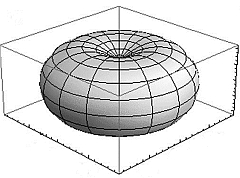Anisotropic light emission from aligned luminophores (Vol. 45 No.4)
 Calculated mission profiles from homeotropically aligned dichroic luminophores illuminated from directly overhead with an order parameter of S2,opt=0.6.
Calculated mission profiles from homeotropically aligned dichroic luminophores illuminated from directly overhead with an order parameter of S2,opt=0.6.
Organic dichroic dyes are neither isotropic in absorption nor in emission. By aligning the fluorophores using liquid crystals, for example, one may gain a degree of control over both the absorption and emission directions of the light. Controlling of light emission directions could have significant impact on the performance of devices such as organic LEDs or luminescent solar concentrators, the latter of which have potential for use as solar energy generators in the built environment. Commercial ray tracing software does not take this dichroism into account, and thus cannot model these devices correctly. In this paper, we develop a simple formalism to describe the resulting emission from a collection of dichroic dyes with arbitrary alignment, including the extremes of planar and homeotropic, and for various degrees of disorder about this alignment. We demonstrate close agreement of the calculations with experimental studies. We close the discussion by accentuating the importance of incorporating these calculations into functioning simulation systems to allow in silico optimization of the devices which will accelerate their entrance into the commercial sphere.
P. P. C. Verbunt, T. M. de Jong, D. K. G. de Boer, D. J. Broer and M. G. Debije, “Anisotropic light emission from aligned luminophores”, Eur. Phys. J. Appl. Phys., 67, 10201 (2014)
[Abstract]






